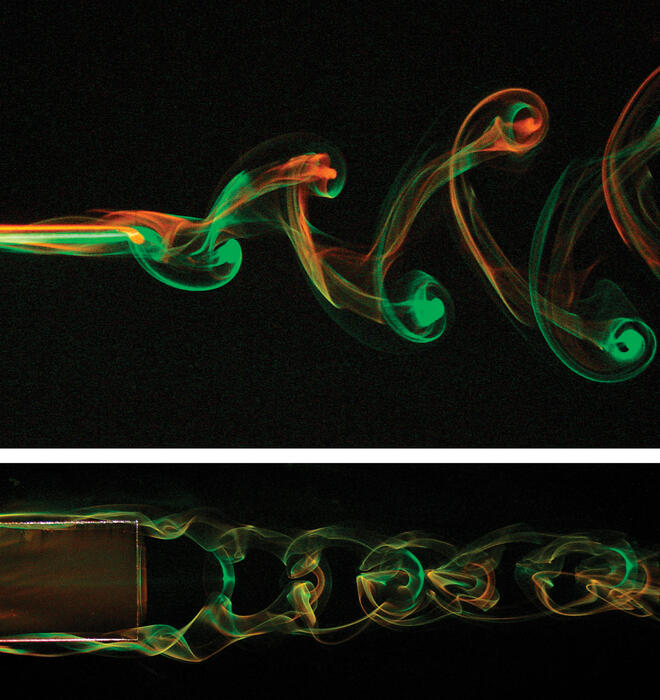
Slide show - More Art of Science images
This stunning computer model captures the strongly irregular, or chaotic, behavior of the Earth’s magnetic field as the north and south poles change places. The poles have flipflopped hundreds of times over the past 160 million years as a result of shifting movement in the molten metal that surrounds the center of the Earth. The last time this happened was 780,000 years ago. Chaos and Geomagnetic Reversals (Christophe Gissinger)
Princeton’s Art of Science exhibition, a showcase of 44 images representing science as an art form, will be on display at the Liberty Science Center in Jersey City, N.J, through Sept. 15. Five photos — and the stories behind them — are featured in the April 24 issue of PAW. Browse additional images in the slide show below.
This stunning computer model captures the strongly irregular, or chaotic, behavior of the Earth’s magnetic field as the north and south poles change places. The poles have flipflopped hundreds of times over the past 160 million years as a result of shifting movement in the molten metal that surrounds the center of the Earth. The last time this happened was 780,000 years ago.
Chaos and Geomagnetic Reversals (Christophe Gissinger)

Nobel Laureate Richard Feynman *42 has described turbulence as “the most important unsolved problem of classical physics.” This image shows both an aerial view and a profile view of a turbulent flow between two parallel walls. Turbulence is by definition chaotic; yet it is full of internal structures. The “structures” within this flowing fluid are outlined in black.
Channeling Turbulence (Melissa Green *09)

Compared to metals, plastics that conduct electricity are lightweight, easily processed, flexible, and inexpensive. Pictured here is a transistor whose plastic interdigitated (interlocking) electrodes replace expensive metals; this same material can be used to make electrical contacts in solar cells and electronic displays.
Electric Pop Art (Kwangseok Lee, Lynn Loo, and Philip Chew)

This long, straight nano-size silicon wire was grown together with two micro-size silicon crystal balls. This structure is potentially similar to a silicon transistor, the key component of electronic devices and one of the most important inventions of the 20th century. The all-silicon nano-bridge may find applications in the next generation of solar cells, iPods, laptops, automobiles and future, as-yet unimagined devices.
Nano Wire Bridges Big Worlds (Chao Wang and Stephen Y. Chou)

Ant colonies generally lack members who act as leaders; yet they are remarkably organized. Each worker applies simple decision rules to limited knowledge and exchanges information with neighbors using rudimentary cues and signals. Complex nests are built, food is gathered, and labor is divided. Studying this collective behavior requires identifying ants as individuals. For this study, each worker ant was marked with a distinctive pattern of colored paint droplets, enabling researchers to better understand how emigrating colonies can choose the best among several new homes, even though few individual workers are aware of all the options under consideration.
Painted Ants (Stephen Pratt)

Ever wonder what the world looks like from a butterfly’s point of view? Here is a compound-eye view of how a Great Spangled Fritillary Butterfly sees another Great Spangled Fritillary Butterfly, from different distances. In the upper left, the second Fritillary is barely visible at 4.3 meters’ distance. The largest image you see, on the top right, is at only 18 centimeters, and at this distance, something fascinating occurs: with the slightest motion, the field of view flashes between all orange and all black. The typical courtship distance for this species is about 18 centimeters. Coincidence? We think not.
The Orange and the Black (Henry Horn)

A laser pulse melted a tiny piece of metal on a silicon chip, resulting in an unexpected shape that looks like a very, very small Easter bonnet. An unintended dust particle serves as a decorative flower on its top. The size of the bonnet in this photo, measured from left to right, is about 45 micrometers, half the diameter of a human hair.
Easter Bonnet (Qiangfei Xia)

This stunning computer model captures the strongly irregular, or chaotic, behavior of the Earth’s magnetic field as the north and south poles change places. The poles have flipflopped hundreds of times over the past 160 million years as a result of shifting movement in the molten metal that surrounds the center of the Earth. The last time this happened was 780,000 years ago.
Chaos and Geomagnetic Reversals (Christophe Gissinger)

Related News
25 Years In, Josh Marshall ’91 Is Still Going Strong at Talking Points Memo
Marshall says there are reasons why the inside-politics website survived while its competitors faded
University Clarifies New No-Recording Policy
The new FAQ says the University community generally has ‘a reasonable expectation of privacy’ in private conversations






No responses yet